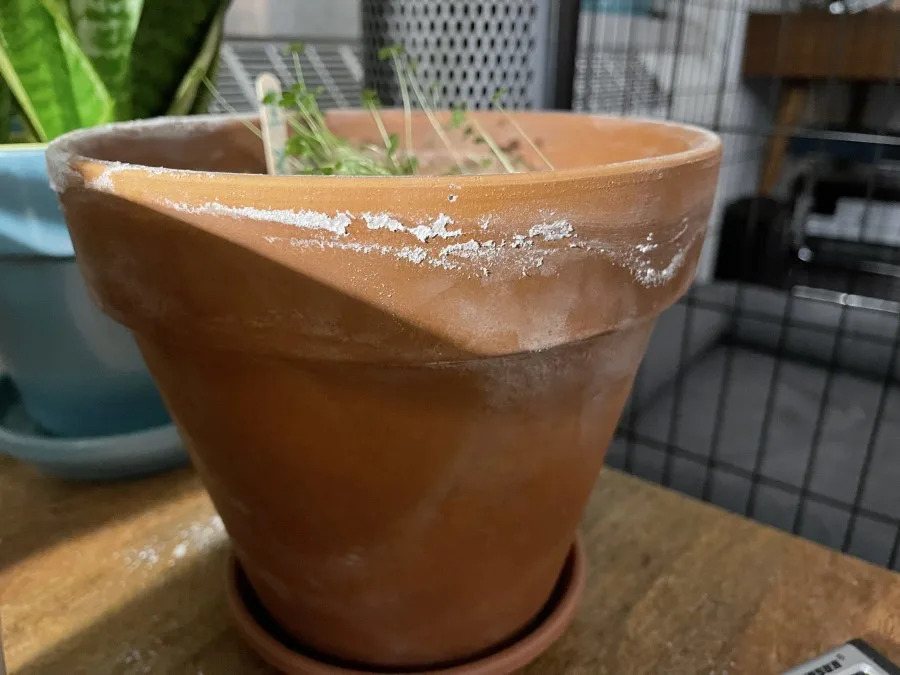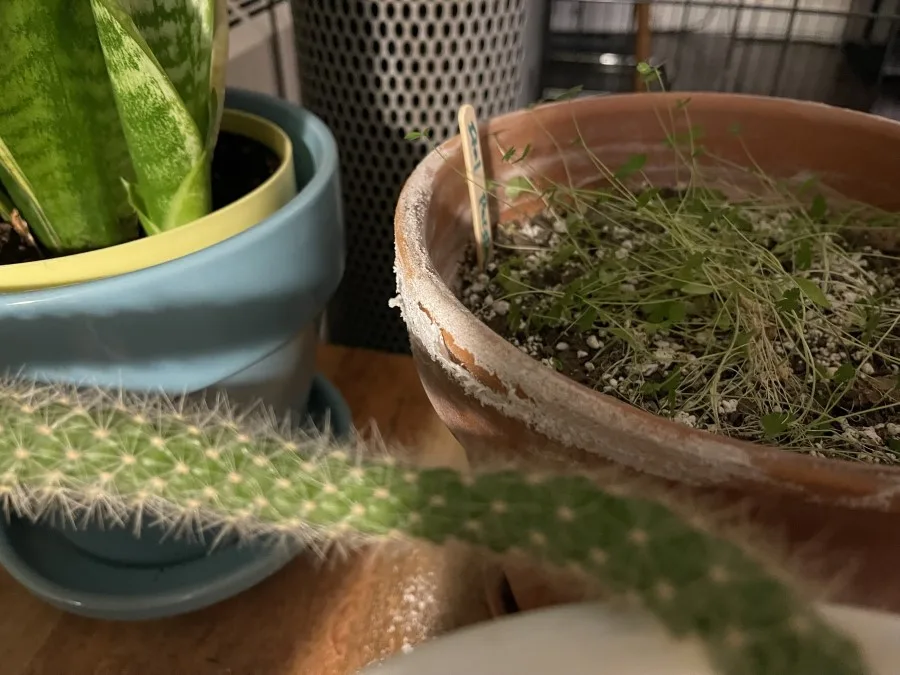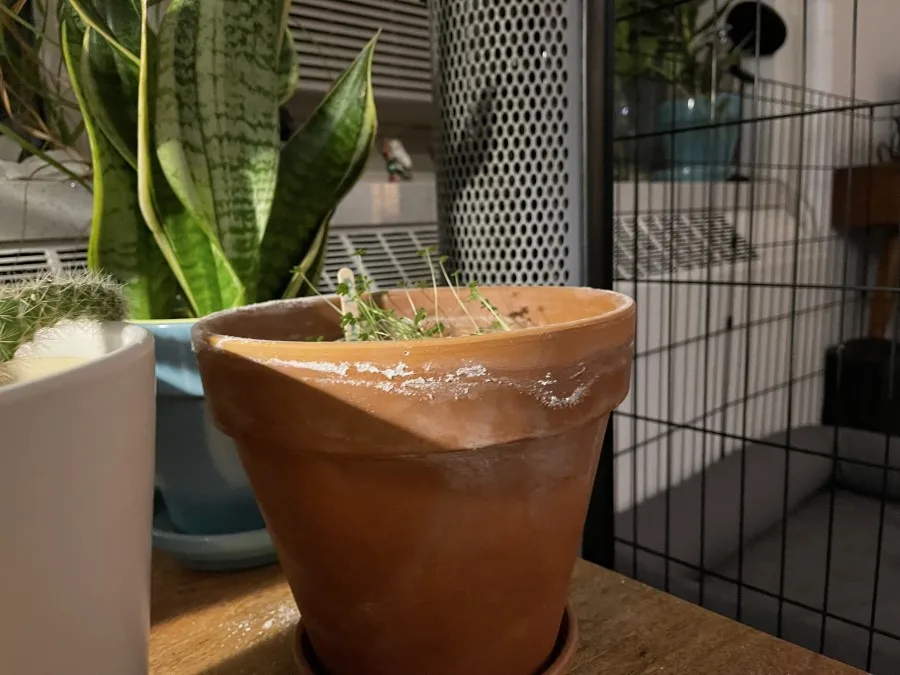Terracotta pots are made from clay, and if you’re into gardening or growing house plants, you’ll know the importance of these pots. They’re widely available in various sizes and help plants not get overwatered by absorbing any excess water. However, if you ever noticed the build-up of white stuff on them, you may want to know what it is.
The white stuff on your terracotta pots is likely excess salts that your plants didn’t use. The salts are dissolved in the water and seep through the porous pot, leaving white residue behind when evaporation happens. Fortunately, it’s harmless to plants and can easily be removed.
Let’s take a detailed look at the white stuff on terracotta pots, if it is dangerous, and how you can get rid of it.

What is the White Stuff on My Terracotta Pot?
Terracotta pots are permeable to water and air. The pores in the pot’s wall allow water and air to flow through and prevent soil and root diseases. However, these pores also allow the water-soluble salts to accumulate on the exterior of the pot.
The white stuff on your terracotta pot is the water-soluble salts that flow through the porous wall of the container and form a white powdered layer on the outer walls of the pot when the water dries up.
Plants require a specific amount of nutrients and minerals for proper growth. If you provide too much of anything, it may cause nutrient burn and damage the plants. Terracotta pots are useful because they allow surplus water-soluble minerals to flow through their porous walls and prevent plants from getting affected.
The excess salts and minerals latch to the outer walls of the pot and form a white crust.
You’ll also observe the same white stuff on the soil and near the drain holes in non-terracotta pots.
As mentioned above, the white stuff is the dried-up nutrients, so if you want to prevent the formation of white crust, it would be best to provide only the required amount of nutrients to your plants. Moreover, you can completely drain the soil to drive out the surplus minerals and salts from time to time.
What is the White Crust on Terracotta Pots Called?
The white crust on terracotta pots is known as efflorescence. Efflorescence is the crystalline residue deposits of salts and minerals left behind on hard surfaces when water evaporates.
The white color of efflorescence is due to its compounds, such as magnesium, potassium, sodium, calcium hydroxides, and carbonates. These compounds are also present in soil fertilizers and nutrient water that you use for your plants.
Efflorescence isn’t unique to terracotta pots so it should not be seen as ia material defect. It’s a natural process, and you can observe it around the cracks on concrete buildings, natural stones, and even woods.
Whenever the soluble salts find space and water to transport them, the capillary movement will help the water reach the outer walls.
When the soluble salts escape to the outer side of the wall, the water evaporates, and the remaining salt is left to interact with the air. The carbon dioxide in the air reacts with the salts and results in what we usually see on the terracotta pots.

Is the White Stuff on Terracotta Pots Mold?
The white stuff on terracotta pots is a mold if it rises off the pots’ surfaces, looks more saturated in color, and feels fuzzy to touch. However, if it has a light consistency and is powdery to touch, it is efflorescence, and not mold.
People find it difficult to distinguish between white mold and efflorescence because both are white and attach themselves to the pot’s walls. However, unlike efflorescence, white mold arises from the fungi that are present in dead plants.
Mold thrive in areas of high humidity. If you have placed your pot in a humid environment, then a combination of moisture and the water-absorbing terracotta pot will be an ideal place for mold growth.
To avoid the growth of mold on your pots, regularly clean out the dead parts of the plants and keep the container in a less humid area.
Make sure that your pot has adequate drainage because poor drainage will cause the bottom of the container to retain moisture which helps mold grow.
Although mold isn’t harmful to plants, it indicates that something isn’t balanced. So, if you observe mold on your plants, start inspecting the soil, stem, and the other parts of your plant to see if there’s any problem. The mold gives you a chance to remedy the issue before the plants get permanently damaged.
Is the Efflorescence on Terracotta Pots Dangerous?
The efflorescence on terracotta pots isn’t dangerous. Efflorescence occurs due to the drying of the excess salts and minerals. These excess salts and minerals are the same minerals and nutrients that plants require for their growth.
Most of the nutrients required by plants are already present in the soil. Using nutrient-rich water on top of fertilizer will increase the number of salts and minerals potentially to excess, resulting in efflorescence. However, since the basis of efflorescence isn’t toxic, it won’t harm the plants.
It would be best if you don’t allow the build-up of the white efflorescence, as too much can start to build up into the soil. Once these salts start to grow inside the soil, they may damage your plants and, if left unchecked.
To prevent efflorescence from harming the plants, filter out the salts in the soil by draining it with considerable water. You can place your pot under a sink and flush it with water that’s double the soil volume. After that, let the soil dry completely to get rid of the excess salts.
Suppose you observe that a white crust has already developed on the soil. In that case, slowly clear the layer before flushing the soil. Repeat this process once every few months to prevent the efflorescence build-up.

How to Get Rid of the White Crust on My Terracotta Pot?
You can get rid of the white crust on your terracotta pot by first removing the plant from the affected pot. Then, you can clean the pot’s inside and outside using a water and bleach solution. You can then replant the plant once the pot is dry.
Follow the steps below to get rid of the white crust on your terracotta pot:
- Make nine-parts water and one-part bleach solution.
- Remove the plant from the affected pot.
- Use a sponge to scrub the inside and the outside of the pot, using the water-bleach solution.
- Wash the pot with tap water and let it dry.
- Replant the plant after the container is completely dried.
You can also make a solution out of baking powder or antibacterial dish wash. The trick is to scrub the pot until the white stuff is removed and rinse it with clean water.
You can also use the same solution to clear out the mold on the terracotta. It might require more effort to be removed, but you should be able to clear it with enough scrubbing.
Since white crust on the walls of terracotta isn’t harmful to your plants, don’t worry if you can’t remove all the markings. However, it would be best to clear your pots regularly so that the efflorescence doesn’t accumulate.
Closing Thoughts
Terracotta pots are excellent containers for your plants. The pores in these pots prevent the plants from dying due to overwatering. However, the holes in the wall also lead to white markings called efflorescence, but it doesn’t harm the plants and is easily removable.
